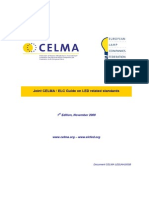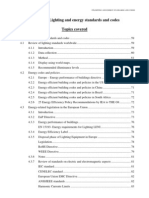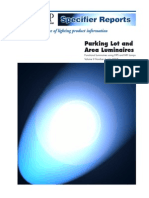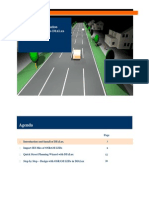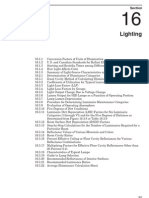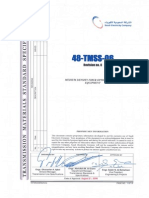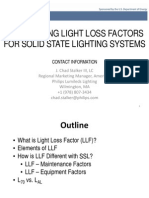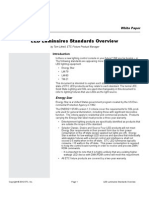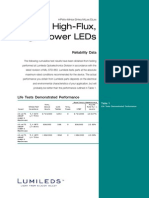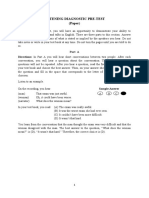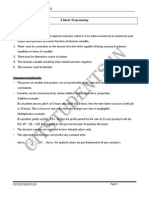Professional Documents
Culture Documents
Iesna Lm80 and Tm21
Iesna Lm80 and Tm21
Uploaded by
cizer_azCopyright
Available Formats
Share this document
Did you find this document useful?
Is this content inappropriate?
Report this DocumentCopyright:
Available Formats
Iesna Lm80 and Tm21
Iesna Lm80 and Tm21
Uploaded by
cizer_azCopyright:
Available Formats
IESNA LM80 and TM21
Mark Hodapp
Philips Lumileds
Senior Application Engineer
370 West Trimble Road
San Jose, CA 95131
T 408 964-2648
F 408 964-5354
mark.hodapp@philips.com
www.lumileds.com
2011 Southeast Region Workshop Tampa, Florida
What is lumen maintenance?
Well understood that LEDs are very long life light sources.
However, the light output of SSL products gradually goes down over time.
Rated lumen maintenance life of the LED (L
p
) is the elapsed operating time over
which the LED light source will maintain the percentage, p, of its initial light output
L
70
(hours) = time to 70% lumen maintenance
L
50
(hours) = time to 50% lumen maintenance
2011 Southeast Region Workshop Tampa, Florida
Lumen maintenance and EPA
EPA is using a simple exponential model for lumen maintenance until TM-21 is
published:
| (time ) = exp( alpha time )
ln (0.7)
alpha =
time
ln (0.7)
alpha (25,000 hour ) = = 1.4267 e 5
25,000
EPA limit LM (25,000) = exp| (1.467 e 5)(6,000)| = 0.918
2011 Southeast Region Workshop Tampa, Florida
Lumen maintenance and EPA
Lumen Maintenance Projection for White >3500K LXML-PWx1
LUXEON Rebel under these conditions
85C, 0.35A (Tjunction ~ 98C) Normalized to 1 at 0 hours
N
o
r
m
a
l
i
z
e
d
L
i
g
h
t
O
u
t
p
u
t
1.2
1.1
1.0
0.9
0.8
0.7
0.6
0.5
Ta within 5C of Ts, in accordance with LM80.
ENERGY STAR 25,000 and 35,000
limits after 6,000 hours of stress
35,000 hour
25,000 hour
EPA: Simple exponential extrapolations
of form:
Flux (time) = exp [ -alpha time]
0 1,000 2,000 3,000 4,000 5,000 6,000 7,000
Hours
2011 Southeast Region Workshop Tampa, Florida
Lumen maintenance and EPA
Lumen Maintenance Projection for White >3500K LXML-PWx1
LUXEON Rebel under these conditions
85C, 0.35A (Tjunction ~ 98C) Normalized to 1 at 0 hours
1,000 10,000 100,000 1,000,000
Hours
2011 Southeast Region Workshop Tampa, Florida
0.5
0.6
0.7
0.8
0.9
1.0
1.1
1.2
N
o
r
m
a
l
i
z
e
d
L
i
g
h
t
O
u
t
p
u
t
Ta within 5C of Ts, in accordance with LM80.
ENERGY STAR 25,000 and 35,000
limits after 6,000 hours of stress
35,000 hour
25,000 hour
*Philips Lumileds recommends
extrapolations of s 6x the test
time
6x test time*
L70 = 162,000 hours
TM-21 protocol:
L70 > 36,000 hours
EPA: Simple exponential extrapolations
of form:
Flux (time) = exp [ -alpha time]
LM-80 Scope
Lumen maintenance test method written by
IESNA (Illuminating Engineering Society of
North America)
LED package, array or module driven by
auxiliary driver
LEDs are driven with external current sources
during operation and lumen maintenance
testing
LED Case temperature is controlled during
operation
During lumen maintenance testing, LED is
allowed to cool to room temperature and tested
at air temperature of 25C
2011 Southeast Region Workshop Tampa, Florida
LM-80 Test Method
LM-80:
IES Approved Method
Specifies
Operation at three case temperatures (55C, 85C and one
selected by manufacturer)
Air Temperature to within +/- 5C, Case Temperature to within
+/- 2C
RH less than 65%
Minimum 6,000 hours, data collected every 1,000 hours
Data collection at 25C
Constant current, rated voltage
Record Lumen Maintenance, Chromaticity, Catastrophic Failures
Reporting Format
2011 Southeast Region Workshop Tampa, Florida
What LM-80 Does Not Specify
LM-80 does NOT specify:
Pass/Fail Criteria
Graphing of results
Curve fitting methods
Extrapolation and L70 prediction methods
Sample Size
How many drive currents
What changes to an LED package require new testing
2011 Southeast Region Workshop Tampa, Florida
EPA ENERGY STAR
Specific
Lumen Maintenance Requirements
Test According to LM-80, by NVLAP accredited lab
Min 25 samples per combination of Temperature and Current
LM > 91.8% at 6,000 hours for residential indoor
LM > 94.1 % at 6,000 hours for non-residential and residential outdoor
Ts point temperature below LM-80 tested temperature
Drive current below LM-80 tested current
2011 Southeast Region Workshop Tampa, Florida
EPA ENERGY STAR
Change in Reporting Requirements
NO CHANGE TO IES REPORT FORMAT. However, this format is not
accepted by EPA
Until 12/31/2010 use IESNA LM-80 prescribed report format
Starting 1/1/2011 new report format
Starting 1/1/2011 devices tested must be of equal or lower CCT than
products being used
2011 Southeast Region Workshop Tampa, Florida
TM-21 What it is, and why it is important
IESNA TM-21 (Technical Memorandum) specifies how to extrapolate the
LM-80-08 lumen maintenance data to times beyond the LM-80 test time.
For example: EPA ENERGY STAR Manufacturers Guide requires L70 of
25,000 or 35,000 hours.
TM-21 is important because it is referenced in the EPA ENERGY STAR
Guides, and customers generally are concerned about getting ENERGY
STAR approvals for their products.
It is also important as it creates a common playing field for LED competitors
to specify lumen maintenance behavior for their white LED products
intended for illumination applications.
2011 Southeast Region Workshop Tampa, Florida
TM-21 status
TM-21 is being written by a panel of industry experts:
6 LED manufacturers (Philips Lumileds, Osram, Nichia, Illumitex,
GE, and Cree).
2 US Government Labs (PNNL, NIST)
Status: Agreement has been reached by panel on basic mathematical
algorithm. First draft is expected to be completed by mid February
2011. IESNA will send draft for Ballot by end of February 2011. After
approval, TM-21 will become a new IESNA document.
2011 Southeast Region Workshop Tampa, Florida
TM-21 Mathematical Algorithm
Manufacturer should normalize the light output to 1 at 0 hours for each unit in the data set.
Data for all units are averaged together (Result represents average behavior).
All average lumen maintenance data points from 0 and less than 1,000 hours are removed.
For 6,000 hour data: average lumen maintenance data points from 1,000 hours to 6,000
hours are fit to a simple exponential extrapolation model using a least-squares curve fit.
For data s 10,000 hours: The last 5,000 hours of data should be used for the lumen
maintenance extrapolation.
For data >10,000 hours. The data points from the last 50% of the total measurement time
should be used. In the case where the last 50% of the total measurement time is not an
integer multiple of 1,000 hours, then the interval shall be rounded-up to the next 1,000
hours should be used. [e.g.: after 11,000 hours of measurement time, the last 6,000 hours
of data should be used].
The L70 extrapolation shall be the lower of: The resulting L70 time OR 6X the LM-80 test
time. [e.g. with 6,000 hours of LM-80 test data, then L70 s 36,000 hours. With 10,000
hours of LM-80 test data then L70 s 100,000 hours.
2011 Southeast Region Workshop Tampa, Florida
TM-21 Mathematical Algorithm
u(t ) = B exp| o t |
TM-21 Example LL
| B |
ln |
\
0.7
.
L70 =
o
Major changes:
B term added to simple exponential
model
Least-squares fit of data starting at
1,000 hours (6Khr data set)
Least-squares fit of data using last
5,000 hours (7K-10K data set)
0 1,000 2,000 3,000 4,000 5,000 6,000 7,000
6X extrapolation time limit
Hours
0.6
0.7
0.8
0.9
1.0
1.1
N
o
r
m
a
l
i
z
e
d
L
i
g
h
t
O
u
t
p
u
t
LL ave
1K-6Khr extrap
Points Used
2011 Southeast Region Workshop Tampa, Florida
Lumen maintenance is not the whole story
LM-80 and TM-21 provide an industry standard for lumen maintenance
testing and for lumen maintenance extrapolations for LED components. LM
79 is the lumen maintenance standard for SSL systems.
Next Generation Industry Alliance and US Department of Energy LED
Luminaire Lifetime: Recommendations for Testing and Reporting, May
2010, discusses practical lifetime considerations for SSL luminaires.
Lumen maintenance is not the dominant failure mode for most SSL
products.
2011 Southeast Region Workshop Tampa, Florida
System Reliability LED Reliability
R
system
= R
electrical
* R
connections
* R
LEDs
* R
optical
* R
thermal
* R
mechanical
Philips Lumileds has developed reliability and lumen maintenance models in order to predict
long-term reliability performance of LUXEON Rebel products. See WP15 Evaluating the
Lifetime Behavior of LED systems for more information.
2011 Southeast Region Workshop Tampa, Florida
You might also like
- Lighting Design - Dialux SoftwareDocument19 pagesLighting Design - Dialux SoftwareChanna AshanNo ratings yet
- TOGAF Series Guide - Business ScenariosDocument51 pagesTOGAF Series Guide - Business ScenarioshananNo ratings yet
- IESNA Guide Testing Lighting Luminaires Using Incandescent Filament Lamps Discharge LampsDocument24 pagesIESNA Guide Testing Lighting Luminaires Using Incandescent Filament Lamps Discharge LampsEslam ElsayedNo ratings yet
- Introduction To The IES Handbook PDFDocument145 pagesIntroduction To The IES Handbook PDFCarlos Alejandro Briozzo33% (3)
- Lighting System DesignDocument2 pagesLighting System DesignReybin AlvarezNo ratings yet
- Standards LED's FINALDocument5 pagesStandards LED's FINALRudy StanciuNo ratings yet
- Interior Lighting Design StandardsDocument4 pagesInterior Lighting Design StandardsNik LuckNo ratings yet
- Help DEHNsupport ToolboxDocument117 pagesHelp DEHNsupport ToolboxGilberto MejíaNo ratings yet
- Ultimate Guide To The Basics of Efficient LightingDocument152 pagesUltimate Guide To The Basics of Efficient LightingNedel LabileNo ratings yet
- Outdoor Lighting StandardsDocument7 pagesOutdoor Lighting StandardsSabir Naseer100% (1)
- GN01 - ILP Guidance Note 1 The Reduction of Obtrusive Light - 2021 V2-60iqakDocument25 pagesGN01 - ILP Guidance Note 1 The Reduction of Obtrusive Light - 2021 V2-60iqakdkshtdkNo ratings yet
- IES Specification - LM 63 2002Document17 pagesIES Specification - LM 63 2002Pablo Kuziw100% (2)
- SLL Code For Lighting 2012Document3 pagesSLL Code For Lighting 2012joxyNo ratings yet
- 554-557 - Tunnel Lighting Systems PDFDocument4 pages554-557 - Tunnel Lighting Systems PDFjavad4531No ratings yet
- Guide To Lighting Best Practice PDFDocument20 pagesGuide To Lighting Best Practice PDFI Kadek Tony Adi SetiawanNo ratings yet
- ITCC UL Catalogue PDFDocument15 pagesITCC UL Catalogue PDFDia HassanNo ratings yet
- Ansi Iesna RP 8 00 ErrataDocument3 pagesAnsi Iesna RP 8 00 ErratajohnvandurenNo ratings yet
- Exterior Lighting SavingsDocument18 pagesExterior Lighting SavingselshoubryNo ratings yet
- Schaefer 1990 PASP 102 212Document18 pagesSchaefer 1990 PASP 102 212Max Jenkinson100% (1)
- LED Parking Garages & ControlsDocument38 pagesLED Parking Garages & ControlsMINo ratings yet
- 4 - Lighting and Energy Standards and CodesDocument34 pages4 - Lighting and Energy Standards and CodesMark Jeffrey PigaNo ratings yet
- Lighting HandbookDocument4 pagesLighting HandbookTharun ThimmegowdaNo ratings yet
- Lighting BSDocument20 pagesLighting BSsanjanaNo ratings yet
- 1 Lighting PresentationDocument53 pages1 Lighting Presentationroco13426ygNo ratings yet
- Project Proposal For Canteen MGMT System For UnileverDocument16 pagesProject Proposal For Canteen MGMT System For Unileversneha lokre100% (1)
- 2011-Ies Handbook For Airfield LightingDocument27 pages2011-Ies Handbook For Airfield Lightingdmc_quinnNo ratings yet
- CIBSE LG 3 Addendum Visual Environment For Display Screen UseDocument7 pagesCIBSE LG 3 Addendum Visual Environment For Display Screen UseIvano DellaPiccaNo ratings yet
- Basics Road Lighting PrintoutDocument47 pagesBasics Road Lighting PrintoutAbdulaziz Alazem80% (5)
- Emergency Lighting Design Guide-GentDocument24 pagesEmergency Lighting Design Guide-GentAli Torabi100% (1)
- Sports Lighting Lux LevelDocument16 pagesSports Lighting Lux LevelMadushan Eranga KumaraNo ratings yet
- CORM 2009 - IESNA Standards On LED and SSL LM79LM80 and Future Standards CORM 2009 Y OhnoDocument28 pagesCORM 2009 - IESNA Standards On LED and SSL LM79LM80 and Future Standards CORM 2009 Y OhnolllltonylllNo ratings yet
- IESNA LM-80-08 Guide To Evaluating LED Lumen MaintenanceDocument2 pagesIESNA LM-80-08 Guide To Evaluating LED Lumen MaintenanceAlex SantiagoNo ratings yet
- LG3update Lighting Guide 3 Addendum 2001Document7 pagesLG3update Lighting Guide 3 Addendum 2001S E Krishnan IyerNo ratings yet
- Iesna lm-45 2000Document15 pagesIesna lm-45 2000jopaypagasNo ratings yet
- 1 - IesnaDocument5 pages1 - Iesnaleidy_pérez_320% (1)
- cc2715 Lighting Solutions 2015 11technical and Index Lighting Design Guide PDFDocument2 pagescc2715 Lighting Solutions 2015 11technical and Index Lighting Design Guide PDFABELWALIDNo ratings yet
- Ninth EditionHandbookErrataDocument22 pagesNinth EditionHandbookErrataDuvan TrillerasNo ratings yet
- BA 220313601 Tap Control TAPCON230 Basic Pro Expert enDocument100 pagesBA 220313601 Tap Control TAPCON230 Basic Pro Expert enPruthvi KrishnaNo ratings yet
- 17th Edition Wiring RegulationsDocument4 pages17th Edition Wiring RegulationsLaura EcaterinaNo ratings yet
- SR ParkingDocument48 pagesSR ParkingMaría Ester Oyarzún GuzmánNo ratings yet
- PTW GroundMatDocument2 pagesPTW GroundMatHossam AlzubairyNo ratings yet
- IES Roadshow IIDocument56 pagesIES Roadshow IItachetNo ratings yet
- Electronic Miter Box! Control A Stepper Motor With A Keypad - Brainy-BitsDocument1 pageElectronic Miter Box! Control A Stepper Motor With A Keypad - Brainy-BitsEduardo UribeNo ratings yet
- Explanation of IP RatingsDocument1 pageExplanation of IP RatingsganeshanNo ratings yet
- CYMGRD Optimal Design of Substation Grounding GridsDocument5 pagesCYMGRD Optimal Design of Substation Grounding Gridsjaneth lozanoNo ratings yet
- 03 - ITCC-Conduits & FlexibleDocument14 pages03 - ITCC-Conduits & FlexibleSajid SaleemNo ratings yet
- Step by Step in DIALux With OSRAM LEDsDocument26 pagesStep by Step in DIALux With OSRAM LEDsTommyc1024No ratings yet
- LightingDocument36 pagesLightingdaodoquang100% (1)
- Motor ClasstyDocument128 pagesMotor Classtywatep_08No ratings yet
- 48 TMSS 06 R0Document0 pages48 TMSS 06 R0renjithas2005No ratings yet
- Road Lighting DesignDocument45 pagesRoad Lighting DesignBello Ahmed Bello100% (2)
- Artigo Sobre A Iesna LM 80 08Document34 pagesArtigo Sobre A Iesna LM 80 08Jeferson NorbertoNo ratings yet
- LM-80-08 Testing Result Summary and L70 Life Prediction: EPA Certified 3 Party LabDocument8 pagesLM-80-08 Testing Result Summary and L70 Life Prediction: EPA Certified 3 Party LabLiyu YangNo ratings yet
- Calculating Light Loss Factors For LED Lighting SystemDocument22 pagesCalculating Light Loss Factors For LED Lighting Systemjieon2002No ratings yet
- Thermo DSQ II PresentationDocument40 pagesThermo DSQ II PresentationSyevana TheLucky ManNo ratings yet
- LM-80 For LED Lumen Maintenance TestDocument2 pagesLM-80 For LED Lumen Maintenance TestLisun GroupNo ratings yet
- Lab SphereDocument44 pagesLab SpherefmtzvargasNo ratings yet
- WP007 LED Luminaires Stds OverviewDocument3 pagesWP007 LED Luminaires Stds OverviewKushal BhanushaliNo ratings yet
- Solid-State Street Lighting Calculating Light Loss Factors: Dana BeckwithDocument25 pagesSolid-State Street Lighting Calculating Light Loss Factors: Dana BeckwithMustaqeem KhanNo ratings yet
- Highflux, Highpower Leds: Reliability DataDocument0 pagesHighflux, Highpower Leds: Reliability DataBudi SulaimanNo ratings yet
- Activity-Sensitive Flip-Flop and Latch Selection For Reduced EnergyDocument35 pagesActivity-Sensitive Flip-Flop and Latch Selection For Reduced EnergyshajehanNo ratings yet
- CS1311 Case Tools Lab RecordDocument70 pagesCS1311 Case Tools Lab RecordSumathi BasNo ratings yet
- User Manual - AQIS Application - TGS - Version 1.0Document35 pagesUser Manual - AQIS Application - TGS - Version 1.0sunru24No ratings yet
- Probability and Stochastic Processes (EE 591) Assignment-2: Prof. S. Dandapat August 17, 2022Document4 pagesProbability and Stochastic Processes (EE 591) Assignment-2: Prof. S. Dandapat August 17, 2022Nibha RanjanNo ratings yet
- LEcture 9 (Software Evolution)Document17 pagesLEcture 9 (Software Evolution)umer farooqNo ratings yet
- Biodata: Phonepe - India'S Payment AppDocument4 pagesBiodata: Phonepe - India'S Payment AppSrinivas RSPNo ratings yet
- Industry - Sub Industry - 1Document7 pagesIndustry - Sub Industry - 1Lead GenNo ratings yet
- Bay31 Role Designer For Sap Presentation PDFDocument19 pagesBay31 Role Designer For Sap Presentation PDFAnonymous 46u73q0J4No ratings yet
- Soal Pre Test 2020 2021Document17 pagesSoal Pre Test 2020 2021Erik NurNo ratings yet
- TV 2023Document13 pagesTV 2023saheb167No ratings yet
- Ad8307 PDFDocument24 pagesAd8307 PDFdabs_orangejuiceNo ratings yet
- Pros and Cons of Earthquake Early Warning - A Quick Review: Rallen@berkeley - Edu Heaton@caltech - Edu Vidale@uw - EduDocument1 pagePros and Cons of Earthquake Early Warning - A Quick Review: Rallen@berkeley - Edu Heaton@caltech - Edu Vidale@uw - EduMark HenriNo ratings yet
- Career Objectives:: Amran Asir HmedDocument2 pagesCareer Objectives:: Amran Asir HmedKamran NaseerNo ratings yet
- 3Document2 pages3Marketing ResearchNo ratings yet
- (Lecture Notes in Electrical Engineering 507) Yang Xu, Hong Xia, Feng Gao, Weihua Chen, Zheming Liu, Pengfei Gu - Nuclear Power Plants_ Innovative Technologies for Instrumentation and Control Systems_.pdfDocument303 pages(Lecture Notes in Electrical Engineering 507) Yang Xu, Hong Xia, Feng Gao, Weihua Chen, Zheming Liu, Pengfei Gu - Nuclear Power Plants_ Innovative Technologies for Instrumentation and Control Systems_.pdfYamin AliNo ratings yet
- Modbus Tcp&RtuDocument4 pagesModbus Tcp&RtuCristian Andres Astudillo MolinaNo ratings yet
- Ghost ErrDocument3 pagesGhost ErrMuhammad Armin IrawanNo ratings yet
- Quiz 4Document11 pagesQuiz 4Win OziracNo ratings yet
- Edit LogoDocument5 pagesEdit LogoMichelius YantoNo ratings yet
- Business Systems AnalystDocument3 pagesBusiness Systems Analystapi-78930984No ratings yet
- E Tool and Corrigo Web: User ManualDocument49 pagesE Tool and Corrigo Web: User ManualVasily IgnatovNo ratings yet
- Revision Worksheet AnswersDocument6 pagesRevision Worksheet AnswersOmarNo ratings yet
- Sqlmap AdvancedDocument6 pagesSqlmap AdvancedBarik GhofurNo ratings yet
- Weather ProjectDocument18 pagesWeather Projectsweety sharmaNo ratings yet
- Syllabus Red Hat LinuxDocument2 pagesSyllabus Red Hat LinuxHarshit KaushalNo ratings yet
- Islamic Core Banking Solution OverviewDocument16 pagesIslamic Core Banking Solution OverviewnadeemuzairNo ratings yet
- (ELECS2) Exp3 - Darlington and Cascode Amplifier CircuitsDocument17 pages(ELECS2) Exp3 - Darlington and Cascode Amplifier CircuitsFrodolfre Reginald Lazo100% (2)
- Linear Programming PDFDocument17 pagesLinear Programming PDFmann20No ratings yet
- Cheat Database Setup GuidesDocument6 pagesCheat Database Setup GuidesOnassis ReyesNo ratings yet






